
Atriplex is a plant genus of about 250 species, known by the common names of saltbush and orache. It belongs to the subfamily Chenopodioideae of the family Amaranthaceae s.l.. The genus is quite variable and widely distributed. It includes many desert and seashore plants and halophytes, as well as plants of moist environments. The generic name originated in Latin and was applied by Pliny the Elder to the edible oraches. The name saltbush derives from the fact that the plants retain salt in their leaves; they are able to grow in areas affected by soil salination.
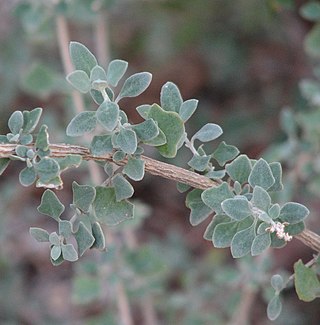
Atriplex amnicola, commonly known as river saltbush or swamp saltbush, is a species of shrub in the family Amaranthaceae. Endemic to Western Australia, it is native to the floodplains of the Murchison and Gascoyne Rivers.

Mirbelia is a plant genus belonging to the family Fabaceae and is endemic to Australia, occurring in every mainland state except South Australia. Plants in the genus Mirbelia are prickly, perennial shrubs with simple, sometimes sharply-pointed leaves, or the leaves absent. The flowers are arranged singly or in groups in leaf axils or on the ends of branches, the sepals joined at the base with five teeth. The petals are usually red, orange, purplish or bluish and the fruit is an inflated pod.
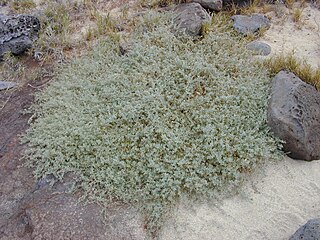
Atriplex semibaccata, commonly known as Australian saltbush, berry saltbush, or creeping saltbush, is a species of flowering plant in the family Amaranthaceae and is endemic to Australia. It is a perennial herb native to Western Australia, South Australia, Queensland and New South Wales, but has been introduced into other states and to overseas countries. It flowers and fruits in spring, and propagates from seed when the fruit splits open. This species of saltbush is adapted to inconsistent rainfall, temperature and humidity extremes and to poor soil. It is used for rehabilitation, medicine, as a cover crop and for fodder. Its introduction to other countries has had an environmental and economic impact on them.

Atriplex cinerea, commonly known as grey saltbush, coast saltbush, barilla or truganini, is a plant species in the family Amaranthaceae. It occurs in sheltered coastal areas and around salt lakes in the Australian states of Western Australia, South Australia, Tasmania, Victoria and New South Wales.
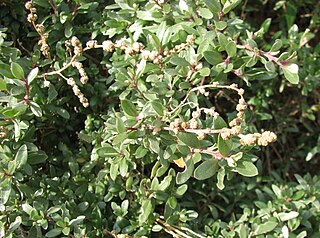
Atriplex paludosa, commonly known as marsh saltbush, is a species of saltbush endemic to Australia.
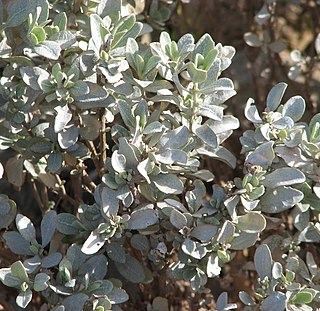
Atriplex vesicaria, commonly known as bladder saltbush, is a species of flowering plant of the family Amaranthaceae and is endemic to arid and semi-arid inland regions of Australia. It is an upright or sprawling shrub with scaly leaves and separate male and female plants, the fruit often with a bladder-like appendage.

Eucalyptus oleosa, commonly known as the red mallee, glossy-leaved red mallee, acorn mallee, oil mallee or giant mallee, is a tree or mallee that is native to Australia. The leaves were once harvested for the production of cineole based eucalyptus oil. Eucalyptus cneorifolia is now the predominant strain used in production due to a higher oil content in new growth.

Atriplex lentiformis is a species of saltbush.
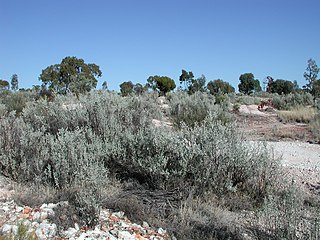
Atriplex nummularia is a species of saltbush from the family Amaranthaceae and is a large woody shrub known commonly as oldman saltbush. A. nummularia is native to Australia and occurs in each of the mainland states, thriving in arid and semi-arid inland regions.
Atriplex parryi is a species of saltbush known by the common name Parry's saltbush. It is native to the deserts and plateaus of eastern California and western Nevada.
Atriplex spinifera is a species of saltbush, known by the common names spiny saltbush and spinescale saltbush.

Atriplex watsonii is a species of saltbush known by the common name Watson's saltbush, or Watson's orach. It is native to the coastline of California and Baja California, where it grows in coastal areas with saline soils, such as salt marshes and beach scrub, with other halophytes such as saltgrass. It extends inland in the Los Angeles Basin, and along the Santa Ana River.

Atriplex gardneri is a species of flowering plant in the amaranth family known by the common name Gardner's saltbush. It is native to western North America from British Columbia to Saskatchewan in Canada south to Nevada and New Mexico in the United States. The specific epithet of the species, gardneri, is misnamed after its first collector, Alexander Gordon. The naturalist Alfred Moquin-Tandon was under the impression that Gordon's last name was Gardner.
Atriplex acanthocarpa is a species of flowering plant in the amaranth family known by the common names armed saltbush, tubercled saltbush, and huaha. It is native to North America, where it is limited to the US states of Arizona, New Mexico, and Texas, and adjacent Mexico.

Atriplex nuttallii, also known as Nuttall's saltbush, is native to central and western North America. It has been treated by some botanists as a synonym of Atriplex canescens.

Eremophila subfloccosa, also known as dense-felted eremophila is a plant in the figwort family, Scrophulariaceae and is endemic to Australia. It is a shrub which often has foliage covered with soft hairs, giving the plant a silvery grey hue and making it soft to touch. The leaves are strongly scented when crushed. Its flowers are usually greenish yellow in colour and have the stamens protruding from the ends. Dense-felted eremophila is common after fire, but becomes less so as others recover and compete with it.

Atriplex holocarpa is a low-growing species of Atriplex (saltbush) found throughout arid regions of Australia. A. holocarpa is commonly known as pop saltbush, because its carpals pop when stepped upon.

Atriplex sturtii, commonly known as saltbush, is an endangered species within the widespread genus Atriplex.A. sturtii is a native Australian shrub and grows in the Channel Country bioregion, also referred to as 'Corner Country'.

Maireana erioclada, commonly known as the rosy bluebush, is a common shrub endemic to Australia, belonging to the genus Maireana.

















